Updated March, 2025
Reformed Worship is delighted to announce the results of our first Visual Arts Awards. Artists were invited to submit entries in any category of art that was created for use in worship spaces, including banners, paraments, bulletin covers, communion ware, stained glass, temporary installations, and furniture.
We received eighty-three entries that covered almost all of those categories. Submissions came from professional artists and amateurs, from individuals and teams, from adults and children. This variety gave an encouraging picture of the growing interest in finding ways to create visually beautiful and nourishing worship spaces.
Artists submitted three identical slides that were sent to our three judges, all professionals in the arts with a long-standing relationship to the liturgical arts as well as to Reformed Worship: Lisa De Boer, professor of art history at Westmont College, Santa Barbara, California, and former member of the RW editorial council (deboer@westmont.edu); George Langebroek, studio artist in St. Catharines, Ontario, and current member of the RW editorial council (905-935-7917); Chris Stoffel Overvoorde, professor of art emeritus at Calvin College, Grand Rapids, Michigan, and an RW editorial consultant as well as a consultant to many congregations (over@calvin.edu).
The judges selected three awards and three honorable mentions; the three award winners each received $250. The judges used the following criteria in their selection:
- visual impact, especially on first impressions
- images that went beyond conventional symbolism or provided new insight into an old symbol
- creative use of the chosen media
- excellent craftsmanship
- fittingness within the worship space
In addition to the award winners and honorable mentions, we plan to showcase some of the many other worthy submissions in this and future issues of Reformed Worship. We’re grateful that all of the artists gave permission for us to contact them for possible future use.
Finally, we are grateful to the Calvin Institute of Christian Worship, Grand Rapids, Michigan, for providing funding for these RW Visual Arts Awards and this full-color issue. With funding provided by the Lilly Endowment Inc., the Calvin Institute continues to help churches develop initiatives that foster grassroots worship renewal (see the announcement on p. 48 about the next round of worship grants).
—ERB
AWARD WINNERS
“Untorn”
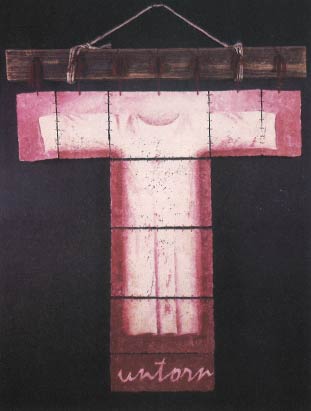
Dimensions/Medium
58"x54", mixed media watercolor on watercolor paper with rice paper, sewn together with red string and hung from nails on a wooden beam.
Artist
Phyllis Thomas (Kangaart@aol.com), Orlando, Florida, is a member of Orlando Community Church. After earning a BS in Art Education and working as an art teacher, she spent eighteen years in Kenya as a missionary, returning to the United States in 1997. She is currently coordinator for a parachurch art ministry. Thomas cites her years in Kenya as a major influence: “Many of my pieces are very earthy; there is a lot of East Africa in my work.” She wrote an essay about the work and read it on Palm Sunday last year when it was hung for the first time (see below).
“Wait”
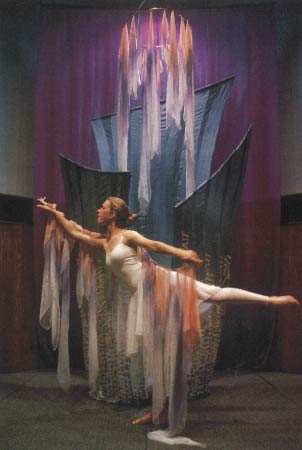
Dimensions/Medium
14'x10'x7', temporary installation/structure using resist dyed silk with choreography.
Artist
Alice Brinkman (ajbbanner@prodigy.net) of Lansing, Michigan, had long wanted to combine a textile installation with dance. This piece was first designed for the large annual community-wide Christian Arts Show in Lansing, now in its fortieth year. Later this installation was performed during a service at University Reformed Church in East Lansing. Brinkman is a textile surface design artist who applies color to cloth and manipulates cloth using a variety of techniques. She has an MS in textiles from the University of Illinois.
She writes,
This structure was based on Isaiah 40:31: “Those who wait for the Lord shall renew their strength, they shall mount up with wings like eagles, they shall run and not be weary, they shall walk and not faint.” Though the textile structure, suspended from the ceiling and resting on the floor, stood alone as a reminder of the “space” we need to wait on the Lord, the work was conceptualized to include a solo dancer. The dancer expressed the theme of what could happen when we cry out and wait for God.
The choreographer/dancer was Rachel Tableman, then a high school student, now studying at Hope College, Holland, Michigan. The dance was accompanied by “We Follow a Star” by Jeff Johnson and Brian Dunning from the CD Celtic Christmas—Selected Artists (1995, Windham Hill Records). The dancer had “wings” attached to her arms. At first she was wrapped in a cocoon-like mesh that was in her way, and she struggled to get free, only to discover that she had wings. She then “flew” using the wings (made of the same fabric as the structure) and finally entered the structure—a place of sanctuary. She ended up attaching the wings to a ring on an invisible pulley system that she then pulled to lift the wings to the highest part of the sanctuary.
"The Crossing”
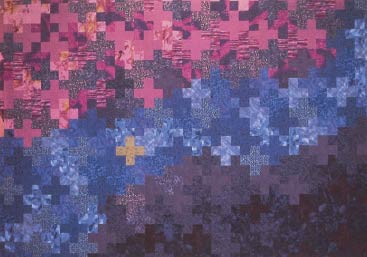
Dimensions/Medium
7'x10' cotton/calico fabrics stretched over a wooden frame.
Artists
The Visuals Team of Northfield (Minnesota) United Methodist Church, chaired by Darlene Cox (acpm@rcon nect.com). Eight amateurs worked on this project: Karin Bartlett, Darlene Cox, Reggie Fineran, Jeanette Gilbertson, Barb Hanisch, Cindy Robinson, Candy Taylor, and Jeanine Taylor.
“The Crossing” was created to illustrate a 2001 Lenten sermon series (Year C) on our personal crossings from destructive to more life-giving faith commitments as we are drawn closer to the love of God. The purple fabrics symbolize repentance for our darker side and the lighter, brighter shades symbolize the hope in what is possible with our Lord’s help. Such crossings are made possible by Christ, symbolized by the single golden cross in the middle of the river (the blue fabrics). “The Crossing” was placed at the front of the church during the series. It was created entirely out of crosses.
HONORABLE MENTIONS
“Good Friday Cross”
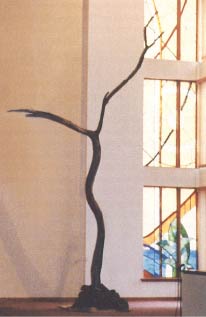
Dimensions/Medium
23' high, average thickness 8", tree placed on a steel base covered with stones.
Artist
Keith Huyer (cornelis@netcom.ca) of Shanty Bay, Ontario, is “a contractor/carpenter married to an artistic wife and father of artistic children.” Huyer writes,
The tree that we are using to represent the cross was nourished by a small brook while it was growing. During its life, the tree provided food for the forest animals and shelter for the birds of the air. Even a homeless person sought its comforting shelter.
The twisted trunk reminds us of the writhing agony that our Lord suffered on the cross. The one branch is like a hand reaching to heaven, echoing the cry of our Savior, “My God, my God, why have you forsaken me?”
Through the shed blood of Jesus, we will one day see the tree of life rooted firmly beside the river of living water (Rev. 22:2, 14).
“Advent Series 1998”
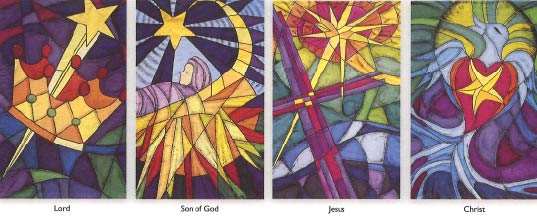
Dimensions/Medium
4'x7' each, tempera/acrylic paints.
Artists
Larry Young (young2393@aol.com) and Joyce Baker. Larry is a graphic designer and Joyce is an art instructor; both serve on the banner committee of First Christian Reformed Church, Denver, Colorado. These panels accompanied an Advent series on the various names for the newborn King of kings.
“Peace”
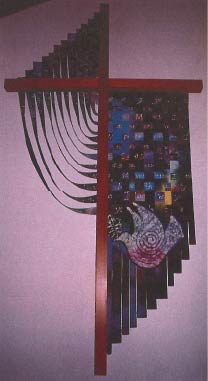
Dimensions/Medium
66"x120" fiber installation, woven strips of resist-dyed cotton juxtaposed with the (permanent) cross at front of sanctuary.
Artist
Alice Brinkman (see “Wait,” p. 5). She writes, “The strips of cloth symbolize life flowing from Christ, who ‘weaves’ into our lives and gives us peace, the peace that comes only from God through Jesus’ work on the cross.”

